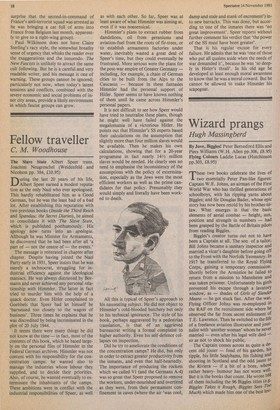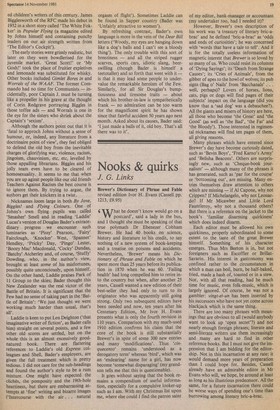Wizard prangs
Hugh Massingberd
By Jove, Biggles! Peter Berresford Ellis and Piers Williams (W.H. Allen pp.306, £8.95) Flying Colours Laddie Lucas (Hutchinson pp.303, £8.95) These two books celebrate the lives of two essentially Peter Pan-like figures: Captain W.E. Johns, an airman of the First World War who has thrilled generations of schoolboys, with his ripping yarns about Biggles; and Sir Douglas Bader, whose epic story has now been retold by his brother-inlaw. What emerges is that the basic elements of aerial combat — height, sun, position and strength in numbers — had been grasped by the Battle of Britain pilots from reading Biggles.
Biggles's creator turns out not to have been a Captain at all. The son of a tailor, Bill Johns became a sanitary inspector and married a vicar's daughter before going off to the Front with the Norfolk Yeomanry. In 1917 he transferred to the Royal Flying Corps, gaining a temporary commission. Shortly before the Armistice he failed to return from a mission to Mannheim and was taken prisoner. Unfortunately his girth prevented his escape through a lavatorY window, as — shades of Girls of Slender Means — he got stuck fast. After the war, Flying Officer Johns was re-employed in the RAF on the recruitment side where he observed the far from secret enlistment of T.E. Lawrence. Then he switched to the life of a freelance aviation illustrator and journalist with 'another woman' whom he never married — even after his legal wife died — so as not to shock his public. The Captain comes across as quite a decent old josser — fond of his garden, his tipple, his little Sealyhams, his fishing and shooting in Scotland and the odd jaunt to the Riviera — if a bit of a bore, whose rather heavyhumour has not worn well But it is the books that count. He wrote 168 of them including the 96 Biggles titles (e.g. Biggles Takes it Rough, Biggles Sees Too Much) which made him one of the best lov ed children's writers of this century. James Bigglesworth of the RFC made his debut in 1932 in a short story called 'The White Fokker' in Popular Flying (a magazine edited by Johns himself and containing punchy leaders on our air strength written from 'The Editor's Cockpit').
The early stories were grimly realistic, but later on they were bowdlerised for the juvenile market. 'Great Scott!' or 'My Gosh!' took the place of fruitier expletives and lemonade was substituted for whisky. Other books included Gimlet Bores in and Worrals of the WAAF. The former Commando had no time for Communists — incidentally, poor Captain J. must be turning like a propeller in his grave at the thought of Corin Redgrave portraying Biggles in those toffee ads — and Worrals is one in the eye for the sisters who shriek about the Captain's 'sexism'.
Although the authors point out that it is 'fatal to approch Johns without a sense of humour, or, indeed, any literature from a doctrinaire point of view', they feel obliged to defend the old boy from the inevitable charges of glorifying war, violence, racism, jingoism, chauvinism, etc, etc, levelled by those appalling librarians. Biggles and his jolly team even have to be cleared of homosexuality. It seems to me that when you are up aginst people like our old friends Teachers Against Racism the best course is to ignore them. By trying to argue, the authors get their knickers in a twist.
Nicknames loom large in both By Jove, Biggles! and Flying Colours. One of Johns's own flying pupils was called 'Smasher' Smell and in reading `Laddie' Lucas's version of Douglas Bader's extraordinary progress we encounter such luminaries as `Pissy' Pearson, 'Fairy' Fairclough, 'Knocker' West, 'Spanner' Hendley, Tricky' Day, 'Pingo' Lester, 'Boozy Mac' Macdonald, 'Cocky' Dundas, `Batchy' Atcherley and, of course, 'Stuffy' Dowding, who, in the author's view, brought at least some of his misfortunes, possibly quite unconciously, upon himself. On the other hand, Laddie praises Park of 11 Group to the skies; Bader thought this New Zealander was the real victor of the Battle of Britain. It is significant that the Few had no sense of taking part in the 'Battle of Britain': 'We just thought we were working much harder than usual, that's all'.
Laddie is keen to put Len Deighton ('that imaginative writer of fiction', as Bader calls him) straight on several points, and a few other old scores are settled, but on the whole this is an almost excessively goodnatured book. There are flattering references to Laddie's old Express colleagues and Shell, Bader's employers, are given the full treatment which is pretty tedious. I did not care for the sub-headings and found the author's style to be a rum mixture. One might have expected the cliches, the pomposity and the 19th-hole heartiness, but there are embarrassing attempts at 'fine' writing and bizarre images (Intercourse with the air . . . natural orgasm of flight'). Sometimes Laddie can be found in Sapper country (Bader was 'Unfairly attractive to women').
By refreshing contrast, Bader's own language is more in the vein of the Dear Bill letters ('Woody, my eyes are hanging down like a dog's balls and I can't see a bloody thing'). The only trouble with this sort of breeziness — and all the striped rugger scarves, sports cars, idiotic slang, beerswilling (though Bader is himself a teetotaller) and so forth that went with it — is that it may lead some people to undervalue the remarkable heroism of the Few. Similarly, for all Sir Douglas's bumptiousness and tiresome traits — about which his brother-in-law is sympathetically frank — no admiration can be too warm for the magnificent spirit he has shown since that fateful accident 50 years ago next month. Asked about its causes, Bader said: 'I just made a balls of it, old boy. That's all there was to it'.



































 Previous page
Previous page